Dr Vino's wine blog
wine talk that goes down easy
Michel Rolland out: was he pushed or did he jump?
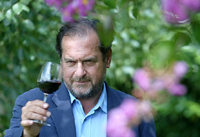 Michel Rolland, the controversial wine maker whose signature adorns over 100 wines around the world, has announced he will be stopping his consulting work to some 20 chateaus in Bordeaux. Rolland was placed on a low circle of the inferno in the 2005 documentary Rolland drops Bordeaux consultancies
Michel Rolland, the controversial wine maker whose signature adorns over 100 wines around the world, has announced he will be stopping his consulting work to some 20 chateaus in Bordeaux. Rolland was placed on a low circle of the inferno in the 2005 documentary Rolland drops Bordeaux consultancies
decanter.com, February 8, 2007
By Adam Lechmere, and Panos Kakaviatos
“Michel Rolland has dropped some 20 consultancies – among them Chateau Kirwan – because of pressure of work.” Continue
Rolland leaves Chateau Kirwan under Mondovino cloud
decanter.com, January 29, 2007
By Panos Kakaviatos
“Celebrated flying winemaker Michel Rolland has left Chateau Kirwan, with the estate owners saying they are looking for higher quality.” Continue reading in cached version–original page is now mysteriously blank.
So was he pushed or did he jump?
Related: “Meeting Michel Rolland”
“Michel Rolland: the man, the myth, the legend“
Marcel Ducasse bids adieu to Lagrange
I walked to my place. There were 14 glasses of red wine in front of me. But not just any red wine–Chateau Lagrange. I knew this was going to be good.
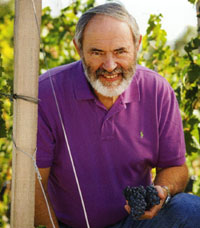 Many of New York’s A-list wine writers (somehow I was invited) turned up for lunch today at Union Square Cafe to celebrate–and taste through–the career of Marcel Ducasse. For 23 years, Ducasse has been the winemaker at Chateau Lagrange in St. Julien. He will soon be able to literally hang out his “gone fishing” sign since he will be spending time on his boat and with his family in Arcachon. Although he is a sage voice in the industry, he let the wines do most of the talking today.
Many of New York’s A-list wine writers (somehow I was invited) turned up for lunch today at Union Square Cafe to celebrate–and taste through–the career of Marcel Ducasse. For 23 years, Ducasse has been the winemaker at Chateau Lagrange in St. Julien. He will soon be able to literally hang out his “gone fishing” sign since he will be spending time on his boat and with his family in Arcachon. Although he is a sage voice in the industry, he let the wines do most of the talking today.
In late 1983, Suntory Ltd of Japan purchased the chateau for 54 million French francs (at the then-exchange rate of 8.38 francs to the dollar, that’s $6.4 million). Interestingly, one company official there today told me that they encountered some local patriotism that resented a “crown jewel” being purchased by foreigners. Although a classified growth in the 1855 classification, this “jewel” was in need of a lot of TLC. Ducasse, who was then brought on board, told us that the company has proceeded to pour ten times the original purchase price into the property. They needed 13 years stanch the losses and become cash-flow positive.
If there was one theme that Ducasse touched on today it was that the vintages are getting warmer. “When I started in the wine business, it was a miracle–a dream!–when the cabernet reached a level corresponding to 12% alcohol,” he told the gathered crowd of scribes. Now, 13% is the norm. Since 1995 the vintages have been decent, good or very good–but none has been disastrous. The summers are now warmer, drier and sunnier.
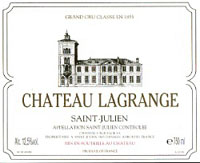 We tasted the components of the 2005 vintage–only cabernet sauvignon, merlot and petit verdot are planted on the chateau’s 115 hectares. Each good in their own right, the cabernet offered aromas of dark fruits, violets and firm tannins while the merlot–though no wimp–was softer with earthy notes and truffle aromas. The petit verdot was a tannin bolt. The blend transcended these component parts and showed a beautiful complexity at this early stage. In the excellent yet overpriced 2005 vintage, this is a tremendous value at under $50 a bottle (find this wine).
We tasted the components of the 2005 vintage–only cabernet sauvignon, merlot and petit verdot are planted on the chateau’s 115 hectares. Each good in their own right, the cabernet offered aromas of dark fruits, violets and firm tannins while the merlot–though no wimp–was softer with earthy notes and truffle aromas. The petit verdot was a tannin bolt. The blend transcended these component parts and showed a beautiful complexity at this early stage. In the excellent yet overpriced 2005 vintage, this is a tremendous value at under $50 a bottle (find this wine).
Then we moved back in time. We had a glass of each of the vintages from 1995-2004 served blind. The 2002 stood out to me as excellent and again it is reasonably priced at $50–though I found one vendor selling it for $37. At that price, this is a wine to buy by the case–get the duct tape out and seal it up for another 10 years. How do I know?
Because next we tasted the 1989 and 1990. Although these wines were from a different climatological era, they were fully resolved, delicately balanced, and hugely appealing right now. If anything, I gave the 1990 the edge but they are rewarding. And the best news of all? These lovely mature Bordeaux can be had a fraction of today’s prices since each is under $100 a bottle (find the 1990; find the 1989). If you want to taste a real claret, try is 1988. It is a trip back in time in more ways than one.
Continuity will likely be the key at Chateau Lagrange. Suntory remains the owner. And Bruno Eynard, who assumes the winemaking duties, has already been the numéro deux there for 17 years. Having raised the bar, the team aims to keep it there.
Bono: wine geek
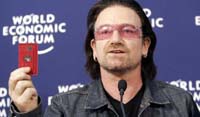
Bono, the rock star and activist, can add wine savvy to his file with the Nobel committee in Oslo. This according to “60 Minutes” producer John Hamiln who recently wrote about travling with Bono in the NYT:
If the private plane and police escort weren’t enough, U2 had an extra perk that officially puts it over the top in my book. It turns out that Bono; U2’s manager, Paul McGuinness; and their tour manager, Dennis Sheehan, are all oenophiles. On the [charter] plane home to Nice that night, the Bordeaux was outstanding — properly aged and poured at the perfect temperature by unfailingly polite British flight attendants.
How sweet it is! Apparently though for Hamlin, the experience made his commercial flight home and the $5 mini bottle of generic “red” particularly bittersweet.
Maybe we will see a not-so-generic red from Bono himself? His other “red” products for AIDS research already include a red Amex and a red iPod among other things…
 tags: wine | bono | charter jets
tags: wine | bono | charter jets
Tasting sized pours
Wine Blogging Wednesday takes a turn for the unusual. This time, instead of just getting a bunch of wine recommendations, you can also win a book! [basic juice]
The Bordeaux glut, under the microscope [Time]
COPIA, a Napa attraction dedicated to food and wine, strugles to avert financial collapse. [Napa Valley Register]
Brits get warnings on wine labels: wording is still undecided. Could range from “Please Drink Sensibly” to the extensive US Surgeon General-style. Will they be alerted to the presence of sulfites? [Telegraph]
Smoking banned in public places–in France! Starts February 07. Mayor Daley, take note. [WaPo]
Malcolm Gladwell writes in last week’s New Yorker about whether a computer could predict movie hits. We already have that in wine: Enologix.
Michel Rolland, the man, the myth, the legend: part deux
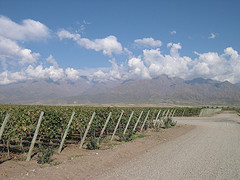 [For part I of this story click here.]
[For part I of this story click here.]
The wines included three vintages from Clos de los Siete in Argentina and four Dourthe properties from Bordeaux.
As with many Argentine wines, the Clos de los Siete packs a lot of punch for a $15 red. Mostly malbec, Rolland blends in healthy doses of cabernet sauvignon and merlot as well as a dollop of syrah, something he couldn’t do in Bordeaux. These are big wines, not for the faint of heart.
The first commercial vintage of 2003 I found to be an abrupt combination of dark fruits and alcohol. (find this wine) The 2004 I found more balanced between the fruit and the alcohol—it’s elegant in the way that a woman on a Harley Davidson is elegant. (find this wine) The 2005, Rolland assured us, would be the best wine of the three but at this point I was surprised by its monochromatic heft that made me want to sing “oh tannin-bomb.†He said that it would settle down quickly since it was just bottled 2 months ago. (find this wine)
The 2003 Bordeaux wines were stylistically different and varied. The Ch Pey de la Tour has a rich style but had a light minerality that the Argentines lacked. (find this wine) The Le Bosq is a serious wine with notes of leather, dark fruit, beef drippings and vanilla. It made me say “mmm, Bordeaux.†(find this wine) The Ch La Garde is made in a lighter style that was oddly vegetal given the high heat of the vintage. (find this wine) The Ch Belgrave was solid though lacked the depth of the Le Bosq. (find Belgrave 2003)
Do you use American oak, came a question from the crowd?
“No, it’s very peculiar. I don’t like the taste.†Rolland replied. “But that said, maybe we will look at it again soon since it is economically interesting.â€
Huh? I did not understand this sudden flash of economic rationality for the aesthete winemaker with the high fees. That’s like saying you don’t like McRibs but you’ll eat them because they’re $0.99.
So, returning to the Mondovino criticism, does he have a one size fits all solution? The answer appears to be variation within a range. He seems to implement many of the same practices in the vineyard—thinning leaves, reducing yields, and picking late—wherever he goes. He was adamant that while some Argentines are trying to improve their wines with the use of small oak barrels but they had not done enough to lower their yields.
And he no doubt has many similar practices in the winery, though he was less forthcoming about those. But the wines I tasted were different across regions and across vintages.
He is clearly a man of strong views, moderated by a sense of humor, and a love of Argentina. He loves the free reign that his investors have given him in Clos de los Siete and he loves the freedom that Argentina gives him to plant however and whatever he wants. “I am a blender—I love to blend.†He’s mixing it up in the wine world.
* * *
The following day, Rolland appeared on the Leonard Lopate Show on WNYC. Listen here.
See my photos from Argentina, including Clos de los Siete.
Related: “Malbec match-up” [Dr. V]
 tags: wine | Michel Rolland | Clos de los Siete
tags: wine | Michel Rolland | Clos de los Siete
Meeting Michel Rolland
Michel Rolland, the globetrotting consulting enologist, is perhaps best known for playing the role of Mephistopheles himself in the documentary Mondovino. He was shown cackling in the back seat of his limousine smoking cigarillos and urging various winery owners in Bordeaux to “mico-oxygenate.†The film portrayed him as on par with Robert Parker, the Emperor of Standardization and Globalization (read my review of Mondovino here).
So I was surprised to see a different Michel Rolland lead members of the NYC press and trade in a tasting yesterday of seven wines that he had made. Although he wore suit that made him look more like he hangs out at investment banks rather than fermentation tanks, he was charming. He joked and told stories. This was the human face of globalization? He didn’t strike me as particularly fearsome.
Rolland is known as the “flying winemaker†par excellence. He consults to over 100 wineries mostly in Bordeaux where he got his start on the right bank. He wryly observed, “I started making wine in the US before I went to the [left bank] Medoc!†Along with 14 wineries in California, he consults in countries as diverse as India, Tunisia, and Uruguay, which makes him a juicy target for his detractors. His wines are often big and powerful since he likes to pick his grapes late and use French oak barrels. His fees are as high as his Parker point scores.
He said there are three keys to making great wine: great terroir, great grapes, and picking at the right time. Hmm, great wine is made in the vineyard? Sounds as if he might be talking himself out of a job as winemaker.
To illustrate the point that winemaking now requires more attention in the vineyard re recalled his first harvest in California in 1986. As the grapes were coming into the crushpad, a priest was there to bless them. He asked Zelma Long where the grapes had come from. She didn’t know.
Now, it’s all about the vineyard. And he sure has a big one in Argentina with five investors from Bordeaux in Clos de los Siete. (The d’Aulan family, the seventh in the name of the project, withdrew to focus their efforts on their Alta Vista winery) They just started planting in 1999 and quickly covered 450 hectares in vines. Then they stopped. The scary part is they still have 200+ more hectares that they can plant. With a vine density of 5,550 per hectare, that’s 2.5 million vines growing. That’s mucho malbec.
He said that contrary to his portrayal in Mondovino, he does not advise everyone to microxygenate, a process of running small bubbles through the wine during fermentation to soften the tannins. This is particularly the case in Argentina where they have such phenolic maturity that adding oxygen would turn the wines an unpleasant brown.
“The whole argument about globalization and standardization is silly,†he told me after the tasting. He said he doesn’t make wine one according to a formula. “You could taste that here today!â€
But could I? Stay tuned tomorrow for part deux, including tasting notes, his thoughts on American oak and more.
Continue- “Michel Rolland: the man, the myth, the legend, part deux“
Turcaud, Entre Deux Mers, white, 2005
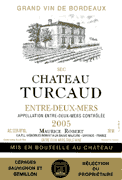 Chateau Turcaud, Entre-Deux-Mers, white 2005. $11 find this wine
Chateau Turcaud, Entre-Deux-Mers, white 2005. $11 find this wine
The Entre-Deux-Mers region of Bordeaux is a misnomer. It’s not between two seas, as the name states, but between two rivers. This wedge of flat land between the Garonne and the Dordogne Rivers used to produce a lot of boring wines but the economic crisis in the area is starting to invigorate the area as a whole. This dry white, a blend of sauvignon blanc (50%), semillon (45), and muscadelle (5) is great value vino from Bordeaux. Luscious notes of pineapple layer on top of crisp acidity giving the wine a great mouthfeel. It’s an excellent companion to potato-leek soup. Mmm, fall is here. Consider this a wine for between two seasons, not seas.
Importer : Fleet Street Wine Merchants
 tags: wine | wine reviews
tags: wine | wine reviews
Tasting sized pours
St. Emilion announced the brand new 2006 clasification yesterday (see my backgrounder). Stephen Brook, author of Bordeaux: People, Power and Politics, sums it up for Decanter.com. The garagistes were excluded.
In a twist, W. R. Tish critiques the critics and rates the magazines that rate wines. Wine and Spirits ends up smelling like a rose–with a hint of pipe tobacco and blackcurrant. Oh wait, points! He rates it a 91. [Wines & Vines]
With 14.8 million visitors in 2003, tasting rooms are bulking up the bottom line for California wineries. More evidence that wine by the glass is highly profitable to those doing the pouring. [SF Chron]
Does Sonoma mean Sonoma? Jess Jackson and the California legislature say yes; Korbel and the Wine Institute say no. It’s up to Gov. Schwarzenegger to sign the bill, as he should. [Press Dem]
UPDATE: Pete Wells, James Beard Award-winning author and NOT on the staff of the NYTimes, has been named the new editor of the Dining section of the Times. An outside hire? A great writer? Sounds excellent to me! [Eater]
 tags: wine | wine news | St. Emilion classification
tags: wine | wine news | St. Emilion classification



